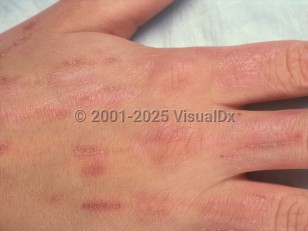Factitial dermatitis in Adult
See also in: External and Internal EyeAlerts and Notices
Important News & Links
Synopsis

Factitial dermatitis (dermatitis artefacta) is a psychiatric condition, characterized by skin lesions that are self-induced to satisfy an unconscious or conscious psychological need, which often is to assume the sick role. Patients will not admit to creating the lesions, which are usually more elaborate than simple excoriations. Factitial dermatitis should be differentiated from malingering, in which lesions are created deliberately for secondary gain, such as collecting disability or evading prosecution. Malingering is not a mental illness. Additionally, factitial dermatitis should be distinguished from neurotic excoriations, in which the patient is aware of, and will typically admit to, scratching or picking.
Clinical appearance depends on the method of self-injury. Dermatitis-like lesions, panniculitis, ecchymosis, ulcers, and vasculitis-like lesions are all possible. The diagnosis tends to occur more frequently in women and in those working in health care. It can be seen in the setting of acute stressors but is predominantly seen in patients with an underlying psychiatric ailment (eg, borderline personality disorder).
The patients' typical lack of concern for how disfiguring their lesions appear is out of proportion to the reality of their presentation. The patient history tends not to corroborate the unusual cutaneous findings. This so-called "hollow history" is a characteristic of the disease. The lesions may be produced by scratching, picking, biting, cutting, burning, injecting, and puncturing and may be produced by hand, instruments, or topical or injectable chemicals. More serious wounds can be complicated by gangrene, abscess formation, or other life-threatening infections. Treatment is often challenging and multidisciplinary.
Related topics: factitious disorders, medical child abuse
Clinical appearance depends on the method of self-injury. Dermatitis-like lesions, panniculitis, ecchymosis, ulcers, and vasculitis-like lesions are all possible. The diagnosis tends to occur more frequently in women and in those working in health care. It can be seen in the setting of acute stressors but is predominantly seen in patients with an underlying psychiatric ailment (eg, borderline personality disorder).
The patients' typical lack of concern for how disfiguring their lesions appear is out of proportion to the reality of their presentation. The patient history tends not to corroborate the unusual cutaneous findings. This so-called "hollow history" is a characteristic of the disease. The lesions may be produced by scratching, picking, biting, cutting, burning, injecting, and puncturing and may be produced by hand, instruments, or topical or injectable chemicals. More serious wounds can be complicated by gangrene, abscess formation, or other life-threatening infections. Treatment is often challenging and multidisciplinary.
Related topics: factitious disorders, medical child abuse
Codes
ICD10CM:
L98.1 – Factitial dermatitis
SNOMEDCT:
402737007 – Artefactual skin disease
L98.1 – Factitial dermatitis
SNOMEDCT:
402737007 – Artefactual skin disease
Look For
Subscription Required
Diagnostic Pearls
Subscription Required
Differential Diagnosis & Pitfalls

To perform a comparison, select diagnoses from the classic differential
Subscription Required
Best Tests
Subscription Required
Management Pearls
Subscription Required
Therapy
Subscription Required
References
Subscription Required
Last Reviewed:05/19/2021
Last Updated:05/23/2023
Last Updated:05/23/2023
Factitial dermatitis in Adult
See also in: External and Internal Eye
